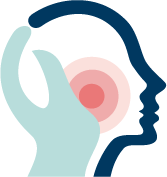
TMJ JAW PAIN
Your Temporomandibular joints (TMJs) or jaw joints must be functioning properly in order to open and close your mouth, to eat or speak. The TMJs allow the jaw to be moved by your jaw muscles and are stabilized by ligaments. Similar to other orthopaedic systems these structures can be compromised by trauma, overuse, and disease with the potential for a wide variety of symptoms.
Temporomandibular Disorders (TMD) are a group of disorders, with similar symptoms affecting the TMJ and related jaw structures.
The common symptoms of TMDs usually include one or more of the following:
-
Pain or discomfort around the jaw joints (TMJs) , ears or face
-
Pain associated with jaw opening and other movements
-
Pain whilst biting or chewing your food.
-
Limitation of jaw range of motion
-
TMJ clicking or grating noise
-
Difficult jaw opening- catching, locking and shifting.
-
A sense of a bite discrepancy
-
Tension in the face
-
Morning headaches in the temples.
-
Sore jaw muscles
-
Neck Tension
In addition, ear symptoms are quite common when a TMD is present. Ear symptoms can include pain, a sensation of hearing loss, stuffiness or fullness, and odd sounds such as ringing, humming, buzzing, and whistling. Other less frequent symptoms include:
-
Loss of balance and a sense of unsteadiness
-
Tingling sensations in the face and jaw
TREATING TMJ PROBLEMS
The pain and discomfort associated with TMJ can vary from mild and infrequent, to severe and debilitating. Depending on the level of pain and associated disability, treatment of TMJ may differ. Of course different treatment options will depend upon addressing the suspected underlying diagnosis/causes. Because there are so many possible causes of TMD, there is no “quick fix” or “cure.” Your TMD symptoms may be temporary and self-limited without serious long-term effects. Most authorities recommend initial focus on conservative and reversible therapies. Research has shown that self-management and conservative treatments are the most successful. The goals of treatment are to decrease pain, to increase jaw function, and to limit the impact of TMD on your daily life. TMD is managed like other joint and muscle problems in the body.
Our specialist doctors will work with you to help you manage your condition and depending on individual problems, may select from one of the following strategies to relieve your pain.
-
Pharmacotherapy. (Prescribed and "natural" medications to reduce pain, muscle spasm etc)
-
Occlusal Splint Therapy. Similar to an orthotic, occlusal splints may help reduce loading forces and tension on the jaw muscles and the TMJ. If a contributing factor is teeth grinding or clenching, a splint can be worn while sleeping to reduce jaw muscle tension and help prevent tooth-to-tooth wear.
-
Self Management and Home Jaw Exercise programme.
-
TMJ injections with local anaesthetic and/or cortisone.
-
Botox injections into the jaw muscles - we are experts - see below
-
Trigger point injections into jaw muscles.
-
Trigeminal nerve branch injections with local anaesthetic.
-
TMJ Arthrocentesis - irrigation and lubrication of the TMJ
-
Referral to various medical and dental specialists.
In cases of severe, constant jaw pain or loss of function, more invasive treatment options such as surgical, are required. Research has shown that for about 5 out of 100 TMD patients, conservative therapy is not enough. These patients may benefit from surgery but only after careful consideration of the various options. In TMJ treatment only a few types of surgery should be considered:
-
Arthrocentesis: This procedure is the least invasive of TMJ surgical procedures and can be done under either local or general anaesthetic. Two needles are inserted into the TMJ, and then fluid is injected to both irrigate and lubricate the TMJ, and flush out inflammatory chemicals. Cortisone is then directly injected into the joint to reduce inflammation.
-
Arthroscopy: This procedure is guided by a very small camera inserted through a small incision in front of the ear. The camera allows the doctor to directly visualise the TMJ for presence of tissue inflammation, fibrous scar tissue or a misaligned articualr disc. The surgeon can then correct the problem by removing inflamed tissue or re-aligning the disc.
-
Open-joint surgery: In cases of severe restriction e.g. TMJ bony ankylosis, the TMJ region may need to be opened to allow a surgeon full view and access to the TMJ for diagnosis and correction.
Other treatment approaches to TMJ pain can also be used, including ultrasound, laser, acupuncture and transcutaneous electrical nerve stimulation (TENS).
Regarding Botox. Dr Delcanho is a recognised authority on the use of Botox injections for Orofacial Pain and TMJ problems. In selected cases Botox injections may be effective in reducing pain from jaw muscles, neuropathic pain and chronic headaches. If interested please speak to our doctors.
